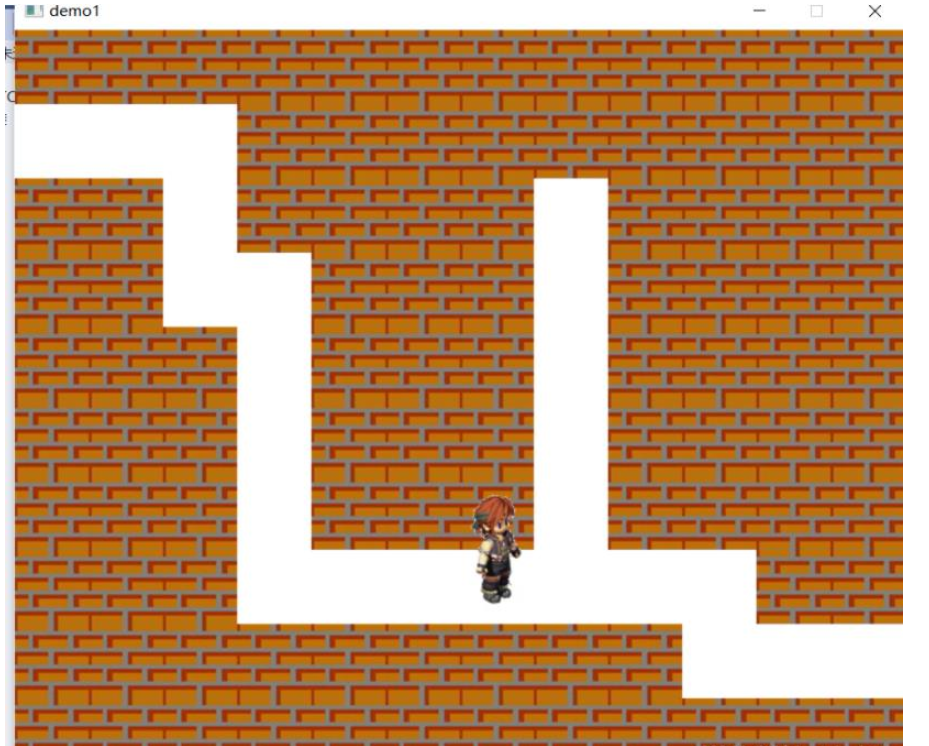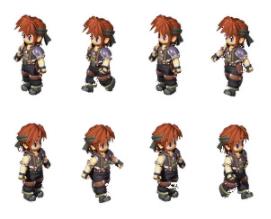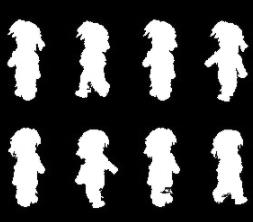本篇内容介绍了“C++基于easyx怎么实现迷宫游戏”的有关知识,在实际案例的操作过程中,不少人都会遇到这样的困境,接下来就让小编带领大家学习一下如何处理这些情况吧!希望大家仔细阅读,能够学有所成!
效果:

#define _CRT_SECURE_NO_DEPRECATEd#define _CRT_SECURE_NO_WARNINGS#include<graphics.h>#include<conio.h>#include<Windows.h>#include<stdio.h>#define LEFT 0//方向#define RIGHT 1#define UP 0//由于当前素材只有左右二个方向,所以上下共用了左右方向#define DOWN 1#define ROAD 0//地图元素类型#define WALL 1#define ENTERX 1//入口 x列,y行#define ENTERY 0#define OUTX 11 //出口 x列,y行#define OUTY 8#define HUMANWIDTH 75#define HUMANHEIGHT 130#define WIDTH 12//地图大小#define HEIGHT 10IMAGE img_human;IMAGE img_human_mask;IMAGE img_wall;IMAGE img_road;int moveNum[2] = { 0 };//当前动作序号int direction;//上下左右四个方向int human_witdh;int human_height;int x, y;//x列数,y行数int map[HEIGHT][WIDTH] = {//地图 { 1,1,1,1,1,1,1,1,1,1,1,1 }, { 0,0,0,1,1,1,1,1,1,1,1,1 }, { 1,1,0,1,1,1,1,0,1,1,1,1 }, { 1,1,0,0,1,1,1,0,1,1,1,1 }, { 1,1,1,0,1,1,1,0,1,1,1,1 }, { 1,1,1,0,1,1,1,0,1,1,1,1 }, { 1,1,1,0,1,1,1,0,1,1,1,1 }, { 1,1,1,0,0,0,0,0,0,0,1,1 }, { 1,1,1,1,1,1,1,1,1,0,0,0 }, { 1,1,1,1,1,1,1,1,1,1,1,1 },};void showbk() {//绘制背景 for (int j = 0; j < WIDTH; j++) for (int i = 0; i < HEIGHT; i++) if (map[i][j] == WALL) putimage(j * img_wall.getwidth(), i * img_wall.getheight(), img_wall.getwidth(), img_wall.getheight(), &img_wall, 0, 0, SRCCOPY); else putimage(j * img_wall.getwidth(), i * img_wall.getheight(), img_wall.getwidth(), img_wall.getheight(), &img_road, 0, 0, SRCCOPY);}void start()//初始化{ loadimage(&img_wall, _T(".\\walls.gif")); initgraph(img_wall.getwidth() * WIDTH, img_wall.getheight() * HEIGHT); loadimage(&img_human, _T(".\\行走素材图.jpg")); loadimage(&img_human_mask,_T( ".\\行走素材图mask.jpg")); human_witdh = 75;//img_human.getwidth()/4; human_height = 130;//img_human.getheight()/2; //putimage(x,y,HUMANWIDTH,HUMANHEIGHT,&img_human,0,0); loadimage(&img_road, _T(".\\road.gif")); x = 0; y = 1;}void updateWithoutInput(){}void drawRole(int x0, int y0)//绘制前景{ putimage((x - x0 / 4.0) * img_wall.getwidth() - 7, (y - y0 / 4.0) * img_wall.getheight() - 70, human_witdh, human_height, &img_human_mask, moveNum[direction] * human_witdh, direction * (human_height - 10), NOTSRCERASE); putimage((x - x0 / 4.0) * img_wall.getwidth() - 7, (y - y0 / 4.0) * img_wall.getheight() - 70, human_witdh, human_height, &img_human, moveNum[direction] * human_witdh, direction * (human_height - 10), SRCINVERT);}void show(int x0, int y0){ showbk(); //clearrectangle(x,y,x+human_witdh,y+human_height); //先显示背景 //准备好遮罩MASK图和源图,三元光栅操作 drawRole(x0, y0); FlushBatchDraw(); Sleep(50);}void readRecordFile(){//读取存档 FILE* fp; int temp; fp = fopen(".\\record.dat", "r"); fscanf(fp, "%d %d", &x, &y); fclose(fp);}void WriteRecordFile(){//保存存档 FILE* fp; int temp; fp = fopen(".\\record.dat", "w"); fprintf(fp, "%d %d ", x, y); fclose(fp);}void updateWithInput(){//增加过度 char input; int olddirection = direction; int oldx = x; int oldy = y; if (_kbhit()) { input = _getch(); switch (input) { case 'a':direction = LEFT; if (map[y][x - 1] == ROAD) x--; moveNum[direction] = 0; break; case 'd':direction = RIGHT; if (map[y][x + 1] == ROAD) x++; moveNum[direction] = 0; break; case 'w':direction = UP; if (map[y - 1][x] == ROAD) y--; moveNum[direction] = 0; break; case 's':direction = DOWN; if (map[y + 1][x] == ROAD) y++; moveNum[direction] = 0; break; case 'W':WriteRecordFile(); break; case 'R':readRecordFile(); break; } if (x != oldx || y != oldy) for (int i = 4; i > 0; i--) {//过渡动画 show((x - oldx) * i, (y - oldy) * i); moveNum[direction]++;//动作序号,一个完整动作分解为四个姿势 moveNum[direction] %= 4; } }}int main(){ start(); BeginBatchDraw(); while (1) { show(0, 0); Sleep(50); if (x == OUTX && y == OUTY)//到达了出口 { outtextxy(0, 0, _T("reach target!")); Sleep(50); break; } updateWithoutInput(); updateWithInput(); } EndBatchDraw(); _getch(); closegraph(); return 0;}


“C++基于easyx怎么实现迷宫游戏”的内容就介绍到这里了,感谢大家的阅读。如果想了解更多行业相关的知识可以关注编程网网站,小编将为大家输出更多高质量的实用文章!




